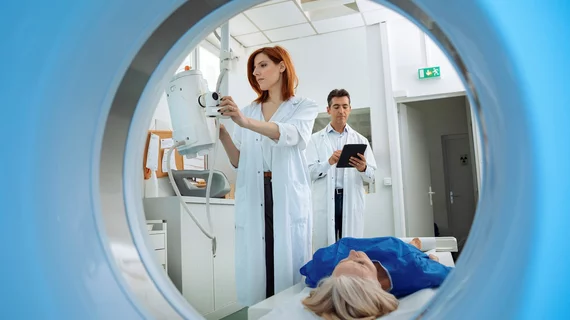Patient shielding is no longer necessary, major radiology groups declare
Shielding patients during x-ray or CT scans is no longer necessary, several major radiology groups in the United Kingdom declared Thursday, dealing the latest blow to this decades-long practice.
Groups including the Royal College of Radiology and British Institute of Radiology said March 5 that their guidance is based on mounds of evidence. Aprons, thyroid and gonad shields provide “minimal or no benefit” to patients, and their use should be discontinued, they urged.
“This guidance offers clarity to both patients and professionals and hopefully will lead to a consistent approach in the future as this provides scientific evidence for change,” Peter Hiles, chairman of the British Institute of Radiology workgroup, said in a statement. “However, it will require a major cultural change in outlook regarding radiation safety and practice in this area.”
When the practice of shielding first started, imaging machines emitted much more radiation, but technical advances in the field have made this practice moot, U.K. radiologists wrote. Oftentimes, patient shields can hinder image acquisition, they added, obstructing the body part and leading to additional exams and potential patient harm.
“Staff are well-trained in positioning the patient so that radiation to the body is minimized, ensuring that the patient is only exposed to enough radiation to achieve a good image,” the team added. “They are also proficient in making the best use of technology to keep radiation dose as low as possible.”
Practice staffers, however, should continue to wear protection in x-ray, CT and interventional radiology suites, since they spend much more time exposed to radiation and at risk, the guidance noted. Others involved in crafting the report include the Institute of Physics and Engineering in Medicine, Public Health England, the Society and College of Radiographers, and the Society for Radiological Protection.
Thursday’s announcement is the latest development in a movement building away from protecting patients from radiation during radiological exams. Just last month, a group of Dutch researchers issued a worldwide call for an end to pelvic shielding, and Kaiser Health News recently documented the growing consensus around abandoning this decades-old practice in the U.S.
However, a recent viral spread of misinformation about thyroid shielding during mammograms illustrates that plenty of work is still needed to educate patients on this shift.

